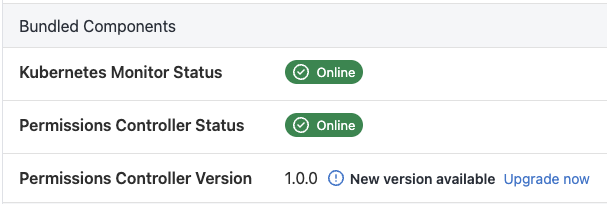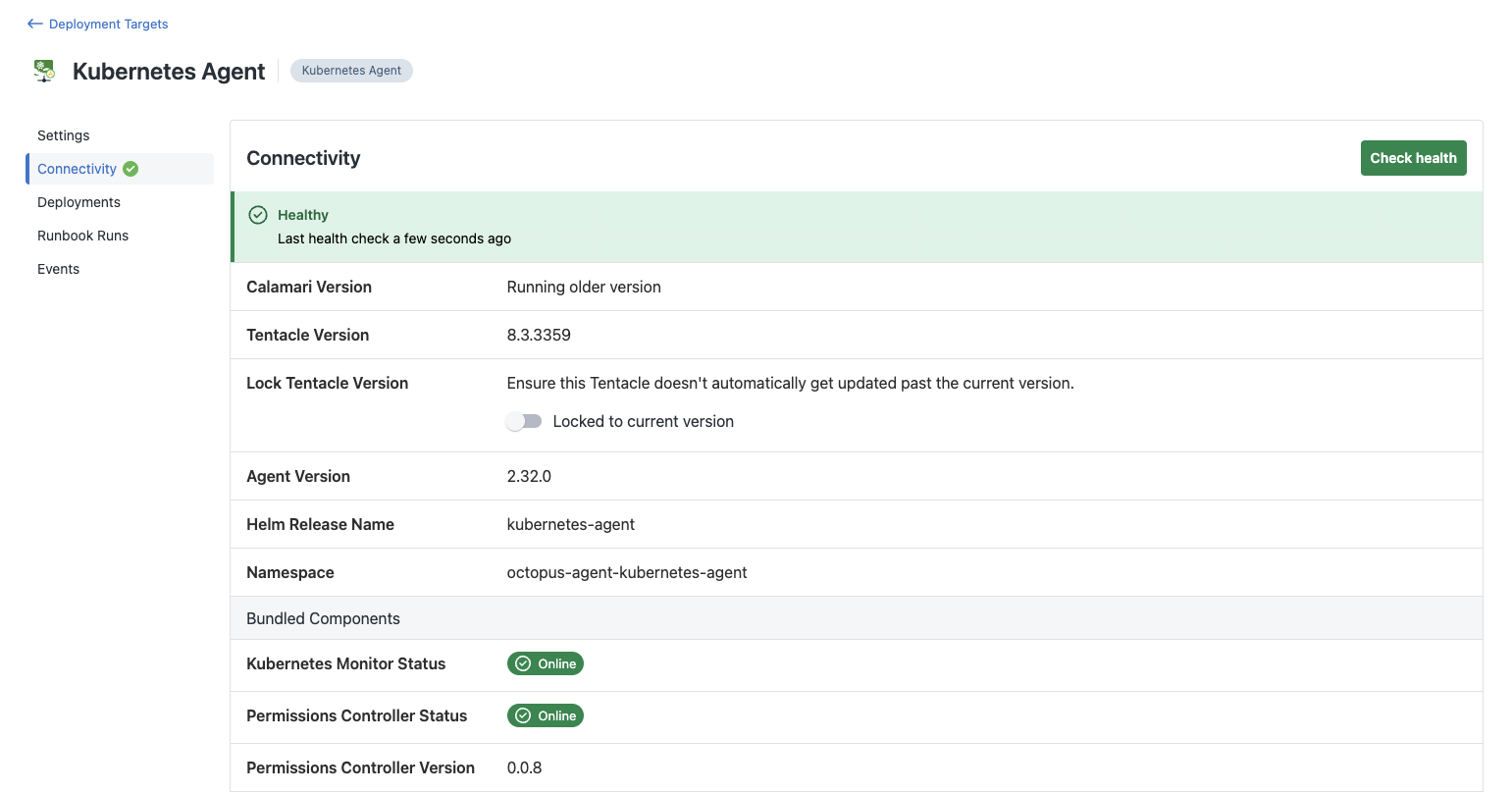Kubernetes offers an RBAC system to lock down what Kubernetes objects your workloads can create and access. The Kubernetes agent supports setting a single service account for your script pods during installation, but this does not fit all use cases.
If you are sharing a cluster between teams and/or environments, granular Kubernetes agent permissions can help lock down your cluster without creating a Kubernetes agent per permission set.
Granular Kubernetes agent permissions works by having the cluster admin create objects on the target cluster that create links between Octopus scope and Kubernetes permissions.
How does it work?
For each namespace you are deploying to in your Kubernetes cluster, you’ll create a WorkloadServiceAccount that specifies which spaces, projects, environments and/or tenants are allowed to act under a set of permissions.
When you don’t create a WorkloadServiceAccount with a matching scope for your deployment, the default script pod permissions configured during installation of the Kubernetes agent will be used instead.
Once you’ve added your WorkloadServiceAccounts, Octopus will handle assigning permissions transparently.
Who should use this feature
Use it if you require principle of least privilege or limited access for your developers. This feature increases friction when creating new applications so we do not recommend it for all circumstances.
How do I use it?
Granular permissions uses a Kubernetes controller and custom resources to configure Kubernetes RBAC per deployment.
Installing Octopus Permissions Controller
Octopus Permissions Controller is a standalone component that is installed via Helm, much like the Kubernetes agent. The installation includes the controller itself and the WorkloadServiceAccount CRD.
Only a single Octopus Permissions Controller is required per cluster.
The below Helm command will install Octopus Permissions Controller.
helm upgrade --install --atomic \
--create-namespace --namespace octopus-permissions-controller-system \
--reset-then-reuse-values \
octopus-permissions-controller \
oci://registry-1.docker.io/octopusdeploy/octopus-permissions-controller-chartPre-requisites:
- Kubernetes agent v2.28.1+
- Cert Manager
Workload Service Accounts
WorkloadServiceAccounts can be created as you would any other Kubernetes object. Your WorkloadServiceAccount should be created in the namespace you will be deploying your application resources into.

Roles and RoleBindings will be created in the application namespace by Octopus Permissions Controller. A linked ServiceAccount will be created in the Kubernetes agent namespace.

When a deployment that matches the scope configured on the WorkloadServiceAccount starts, the created ServiceAccount will automatically be assigned.
Creating Workload Service Accounts
The WorkloadServiceAccount spec consists of two main parts; the scope and the permission set.
apiVersion: agent.octopus.com/v1beta1
kind: WorkloadServiceAccount
metadata:
name: sample-wsa
namespace: your-application-namespace
spec:
scope:
spaces: [default]
projects: [guestbook]
environments: [dev-a,dev-b]
permissions:
permissions:
- verbs: ["*"]
apiGroups: ["*"]
resources: ["*"]
roles:
- apiGroup: rbac.authorization.k8s.io/v1
kind: Role
name: your-existing-roleFor more examples and common scenarios, have a look at the Octopus Permissions Controller repo
Scope
Each WorkloadServiceAccount is assigned a scope with the following fields
- Spaces
- Projects
- Environments
- Tenants
- Steps
These fields are matched against the corresponding slug within Octopus.
Each field adheres to the following rules to match:
- A field that is omitted entirely is treated as a wildcard, it will match any value
- A field with one or more values will match exactly to one or more slugs
- Each value must be a complete slug, partial matches are not supported
Each WorkloadServiceAccount must have at least one non-empty field. You cannot have a WorkloadServiceAccount that matches every scope.
Permissions
The permissions applied for each scope can be configured a couple of ways:
- Directly reference permissions on the
WorkloadServiceAccount - Reference existing
RolesorClusterRoles
Cluster Workload Service Accounts
When non-namespaced scoped permissions are required, ClusterWorkloadServiceAccount are available to configure your permissions. These work the same way as WorkloadServiceAccounts.
Combining WSAs
Not all permissions exist in a vacuum and we don’t want to repeat ourselves too much when creating WorkloadServiceAccount definitions. To help compose your desired permissions, WorkloadServiceAccounts are built additively.
When a workload with a particular scope matches multiple WorkloadServiceAccount scopes, the permissions are combined and both applied to a single ServiceAccount.
Running deployments
With the Octopus Permissions Controller and your WorkloadServiceAccounts configured, running deployments is done exactly as before and it will seamlessly apply the appropriate ServiceAccount that best matches the scope of the deployment.
If there are no WorkloadServiceAccounts that match the deployments scope, the deployment will use the default permissions configured for script pods when you installed the Kubernetes agent.
We recommend restricting the default permissions to be completely empty so that deployments without matching scopes will fail quickly.
Octopus Permissions Controller
How does it work under the covers
Octopus Permissions Controller is in charge of several duties:
- Managing the lifecycle of
WSAs - Creating roles, role bindings and service accounts as defined by your
WSAs - Applying service accounts to your Kubernetes agent script pods that run your deployment workloads
ServiceAccounts are generated ahead of time by calculating the minimum number of unique permissions combinations that are defined by your WorkloadServiceAccounts.
At the time of creation of a new script pod, Octopus Permissions Controller acts as a mutating admission webhook controller to match the scope annotated on the script pod with a matching ServiceAccount (if any).
For some cases (eg. health checks), the Kubernetes agent runs a workload without a specific scope and so no ServiceAccount is applied to the script pod by Octopus Permissions Controller.
Interested in more detail? Check out the Octopus Permissions Controller repository.
Upgrades
Because this component is shared between Kubernetes agents on your cluster, we have opted to separate its upgrade cycle from a single Kubernetes agent.
As we deploy Octopus Permissions Controller as a Helm chart, you can use any method you wish to install new versions. Notification of new versions will be available in the connectivity page of your Kubernetes agent, as well as a command to help upgrade your existing installation.

Installing on a cluster with existing agents
Octopus Permissions Controller can be installed on a cluster with existing Kubernetes agents and it will immediately start applying permissions from matching WorkloadServiceAccounts.
It is highly recommended that you update each of your agents default script pod permissions to be more restrictive. If a matching WorkloadServiceAccount is found, it will correctly apply restricted permissions, but any misconfiguration that results in no matching WorkloadServiceAccount could result in your deployment having more permissive permissions than intended.
For basic installations of the Kubernetes agent, this command will remove default permissions.
helm upgrade --install --atomic \
--create-namespace --namespace ${agent_namespace} \
--reset-then-reuse-values \
--set scriptPods.serviceAccount.clusterRole.enabled="false" \
${release_name) \
oci://registry-1.docker.io/octopusdeploy/kubernetes-agentRemoving Octopus Permissions Controller
If the Octopus Permissions Controller is no longer desired, it can be removed in two steps.
- Uninstall the Helm chart from your cluster. If you installed the permissions controller with the default parameters the commands below will do this.
helm uninstall --namespace octopus-permissions-controller-system octopus-permissions-controller
kubectl delete namespace octopus-permissions-controller-system- Update your Kubernetes agent default permissions if required. This command below will allow for unrestricted deployments.
helm upgrade --install --atomic \
--create-namespace --namespace ${agent_namespace} \
--reset-then-reuse-values \
--set scriptPods.serviceAccount.clusterRole.enabled="true" \
--set scriptPods.serviceAccount.clusterRole.rules=null \
${release_name) \
oci://registry-1.docker.io/octopusdeploy/kubernetes-agentTroubleshooting
Is Octopus Permissions Controller operational?
Octopus Permissions Controller will report it’s status via the health check each of the Kubernetes agents on the same cluster performs.

If the permissions controller is reported as not found, try running a new health check and monitor the Octopus Permissions Controller pod logs in Kubernetes to confirm that the script pod is being discovered.
Deployment fails during verification
When using deployment verification with granular permissions, your deployment may fail during the verification phase even though the resources were created successfully. This occurs because the script pod that performs the deployment also needs to read the deployed resources to verify they reached the desired state.
To resolve this issue, update your WorkloadServiceAccount to include read permissions:
- The
getverb for parent resources (such as Deployments) - The
listverb for child resources (such as Pods and ReplicaSets)
You can further troubleshoot permission related deployment failures by adding kubectl auth whoami and kubectl auth can-i commands to your deployment process using the “Run a kubectl script” step.
Help us continuously improve
Please let us know if you have any feedback about this page.
Page updated on Wednesday, September 24, 2025